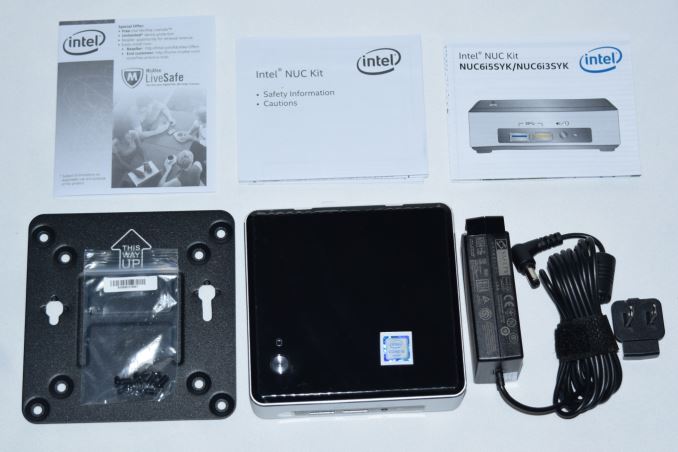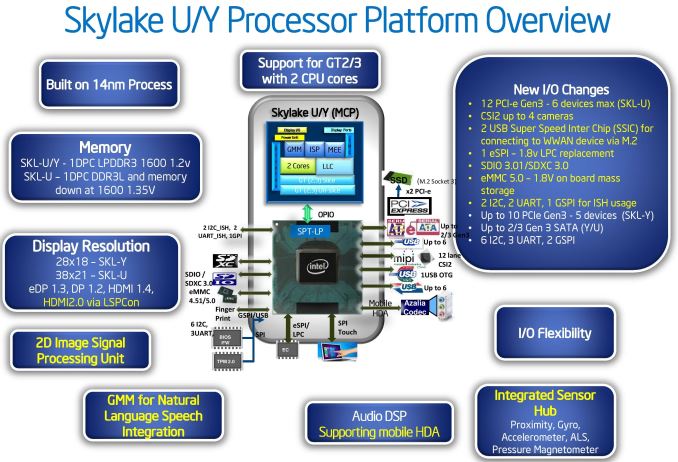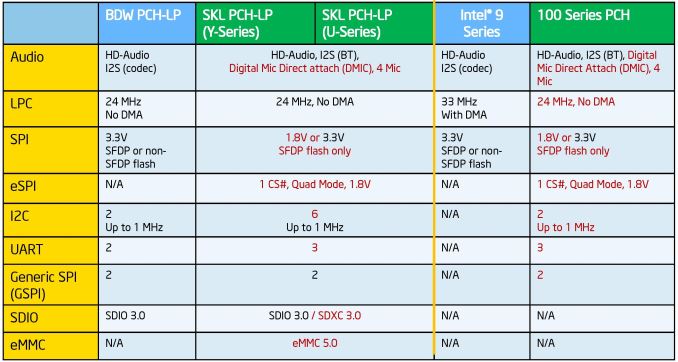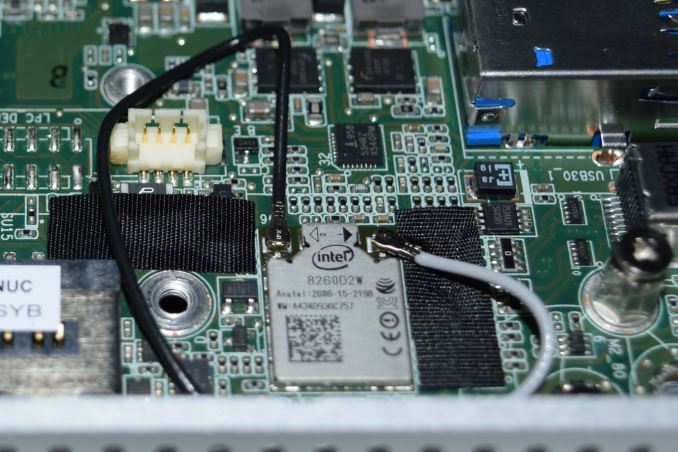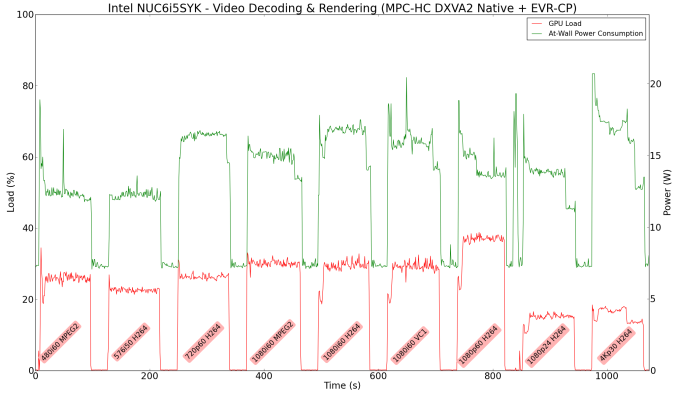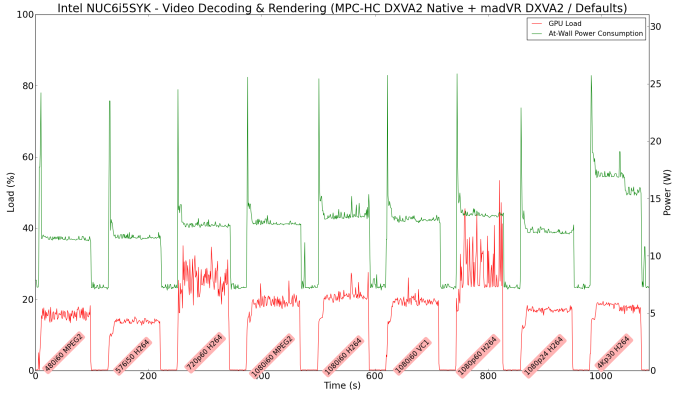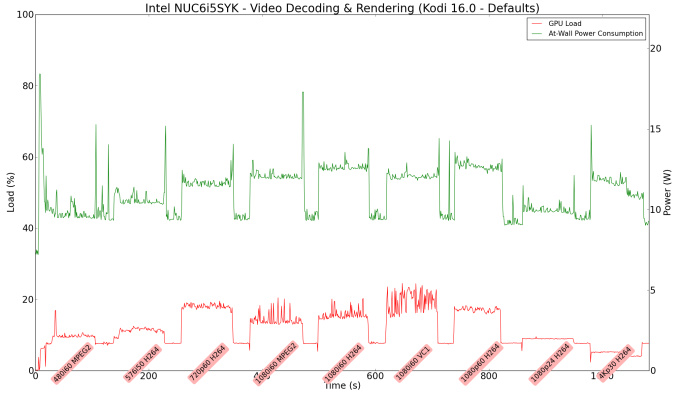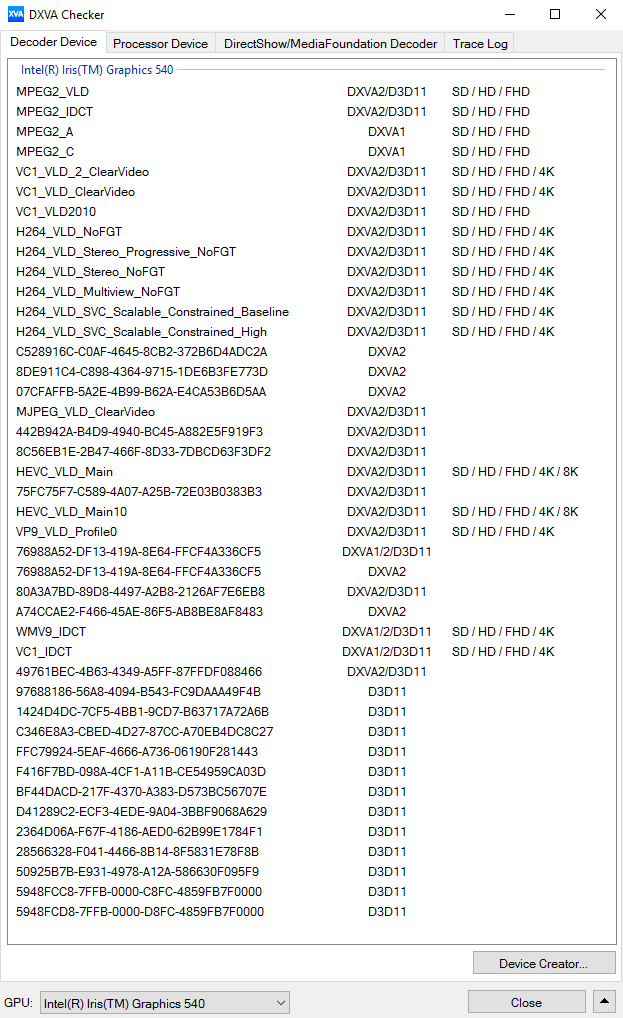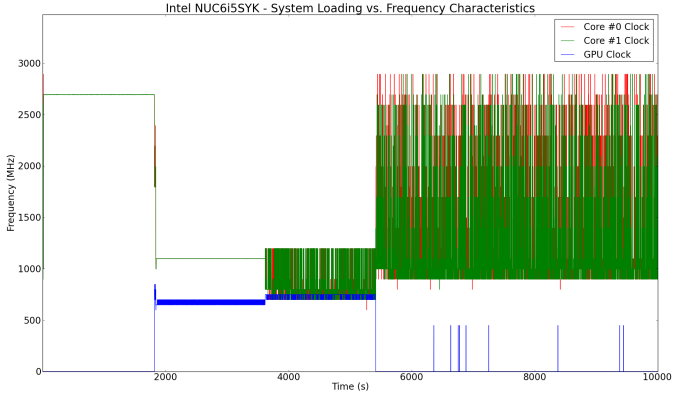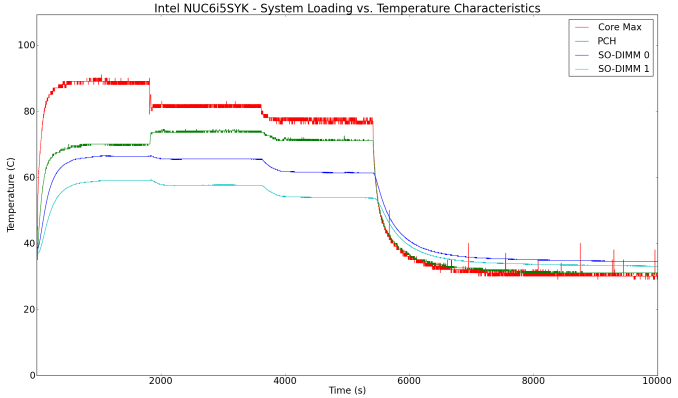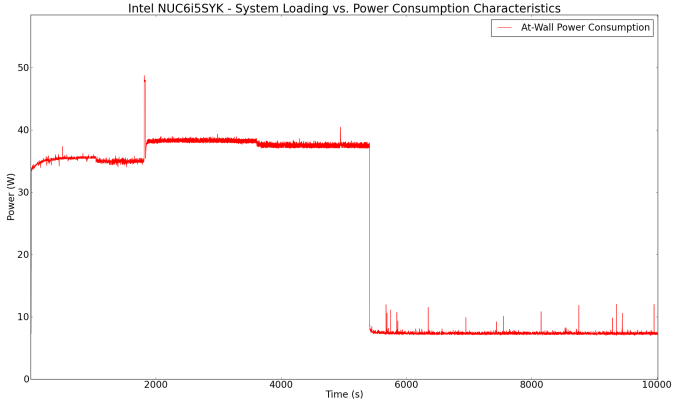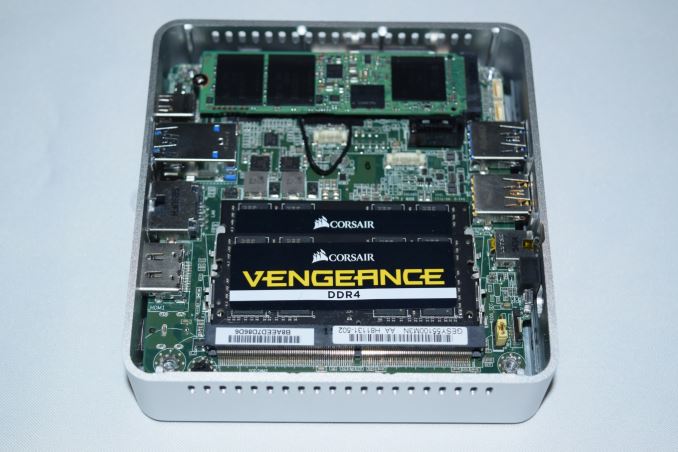
Original Link: https://www.anandtech.com/show/10121/intel-nuc6i5syk-skylake-ucff-pc-review
The Intel NUC6i5SYK Skylake UCFF PC Review
by Ganesh T S on March 11, 2016 8:00 AM EST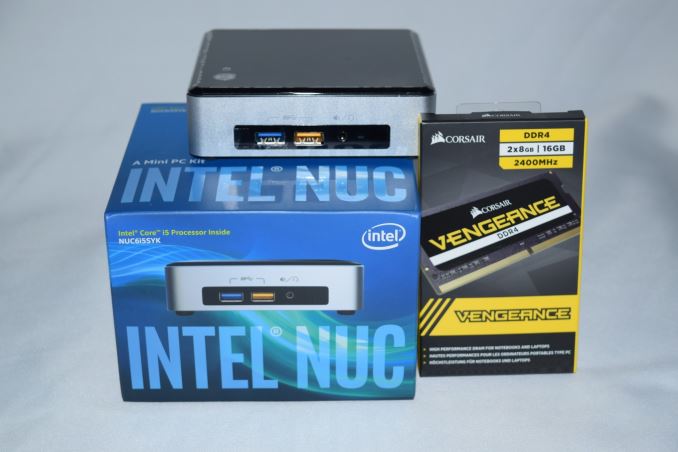
The evolution of computing platforms has left the traditional desktop PC market in a precarious state. However, the miniaturization trend has provided some bright spots. Compact PCs have been around in the mini-ITX form factor for a relatively long time now. The market segment received a massive boost with the introduction of the ultra-compact form factor (UCFF) machines. It all started with the first Intel NUC (Next Unit of Computing) based on a Sandy Bridge processor. Every generation since Sandy Bridge has seen multiple NUCs based on the corresponding U-series processors, and Skylake is no different.
Introduction and Setup Impressions
It is not difficult to identify reasons for the popularity of UCFF PCs and Compute Sticks - performance per watt has seen considerable improvement, and much of the average consumer's traditional desktop work can be done with systems sporting a sub-20W TDP CPU. SSDs are becoming smaller and smaller, first with mSATA and now with M.2 form factors. High speed interfaces such as USB 3.0 have also become ubiquitous, removing the need for dedicating storage space inside the chassis for fast access to large amounts of data. The advent of mobile platforms have also made casual gaming quite popular - and power-hungry discrete GPUs are not needed for those. All these trends have enabled powerful palm-sized computers - the Next Unit of Computing.
Intel has been pushing the performance per watt aspect and GPU performance heavily in the last few generations, making each successive NUC generation more attractive than the one before. We have already looked at multiple Broadwell NUCs. The Skylake NUCs currently come in two varieities - one based on the Core i3-6100U and another based on the Core i5-6260U. The i5 version is marketed with the Iris tag, as it sports Intel Iris Graphics 540 with 64MB of eDRAM.
The NUCs have traditionally been barebones machines - the end-user could choose appropriate storage media for the OS, a mini-PCIe WLAN adapter, SODIMMs and an operating system. Starting with the Broadwell NUCs, Intel introduced some changes in the barebones approach. Only M.2 SSDs are supported (though, select models with the 'H' tag allowed for 2.5" drives). In particular, even though the Broadwell NUCs supported both SATA-based and PCIe-based M.2 SSDs, the PCIe links were only PCIe 2.0 x4. That changes in the Skylake NUCs with full support for PCIe 3.0 x4 M.2 SSDs. While the Broadwell NUCs came with the Intel AC7265 WLAN adapter soldered, the Skylake NUCs come with the Intel AC8260 adapter soldered to the motherboard.
The specifications of our Intel NUC6i5SYK review configuration are summarized in the table below. We used the same Samsung SM951 NVMe drive that Intel supplied with our review sample of the Broadwell-U Iris NUC. The Skylake NUCs are the first UCFF PCs to move to DDR4 for the SODIMMs. Corsair provided us with their 2x 8GB Vengeance 2400 MHz DDR4 SODIMM kit (the NUC only configured it for operation at 2133 MHz, though).
| Intel NUC6i5SYK Specifications | |
| Processor | Intel Core i5-6260U Skylake, 2C/4T, 1.8 GHz (Turbo to 2.9 GHz), 14nm, 4MB L2, 15W TDP |
| Memory | Corsair CMSX16GX4M2A2400C16 DDR4 15-15-15-35 @ 2133 MHz 2x8 GB |
| Graphics | Intel Iris Graphics 540 (Skylake-U GT3e) |
| Disk Drive(s) | Samsung SM951 Series MZVPV256 (256 GB; M.2 Type 2280 PCIe 3.0 x4 NVMe; 19nm; MLC) |
| Networking | Intel Dual Band Wireless-AC 8260 (2x2 802.11ac - 867 Mbps) Intel I-219V Gigabit Ethernet |
| Audio | 3.5mm Audio Jack (Headphone / Microphone) Capable of 5.1/7.1 digital output with HD audio bitstreaming (HDMI) |
| Miscellaneous I/O Ports | 4x USB 3.0 1x SDXC (UHS-I) 1x HDMI 1.4b, 1x mini-DP 1.2 |
| Operating System | Retail unit is barebones, but we installed Windows 10 Pro x64 |
| Pricing (As configured) | $675 |
| Full Specifications | Intel NUC6i5SYK Specifications |
The Intel NUC6i5SYK kit obviously doesn't come with any pre-installed OS. Drivers are available online only. In addition to the main unit, the other components of the package include a 65 W (19V @ 3.43A) adapter, a US power plug, a VESA mount (along with the necessary screws), user manual and a quick-start guide. The kit also includes a promotion for McAfee LiveSafe, but, thanks to the barebones concept, there is no 'bundled bloatware'.
The gallery below takes us around the hardware in the unit.
NUC6i5SYK Review Sample Issues
In the interest of full disclosure, it must be stated that all the benchmark numbers and usage impressions presented in the next few pages are based on the second unit that Intel sent us. Long story short, our first review sample got bricked due to a botched BIOS update, and Intel sent us a pre-configured unit the second time around. However, all benchmarking was eventually done with our own choice of NVMe SSD and DDR4 SODIMMs.
On the first sample (using SODIMMs and a SSD different from what we eventually used), we were not able to install Windows 10, as the unit ended up BSOD-ing within a couple of minutes of starting the installation process. A search online indicated that we were not alone in experiencing such problems. The BIOS version on that sample (0028) was also quite dated. Fortunately, Intel had already seen such issues and indicated that it was due to the DDR4 SODIMM being based on 2133 MHz Hynix modules. The latest BIOS - 0036 - has a new setting in BIOS (Memory tab in Performance) for Round Trip Latency. Disabling this would apparently allow for these SODIMMs to work properly. Unfortunately for us, the BIOS update process ended up getting hung, and a power cycle after 20 minutes bricked the unit. Playing around with the BIOS jumper on the board couldn't recover the unit, and we had to move to the second unit for further benchmarking.
For the second unit, we made sure to use non-Hynix modules. Corsair's supplied SODIMM kit was using DRAM from Samsung, and the second sample that came in already had the latest BIOS (0036) on it. This time around, Windows installed fine. Everything was checking out OK, but, when we started running PCMark 8 workloads, the unit ended up freezing. Our assumption was that Windows update had installed the latest graphics drivers, but, it turned out that we had to manually update it from 4331 to 4352. Updating the drivers helped resolved the freezing issue. After both these showstopper issues were resolved, we were able to proceed with our evaluation process.
Platform Updates
The Skylake NUCs differ from the previous NUCs even from the viewpoint of the chassis, but, before going into that, let us take a look at the Skylake-U platform that enables the updates. The PCH (Sunrise Point-LP) and the processor are integrated in the same package, even though the PCH is fabricated in 22nm, while the processor is in 14nm. The Skylake-U platform has plenty of updates (as shown in yellow in the slide reproduced below), but, relevant to the Skylake NUC is the availability of SDXC 3.0 support in the PCH. Skylake-U also obviously supports DDR4 (as the NUC6i5SYK only supports that), but that is not mentioned in the slide below.
In terms of external design, we have a SDXC slot with support for UHS-I on one side. The HDMI port finally becomes full-sized. The consumer infrared sensor is retained in the front panel. Given that Intel is open to having I/O ports in the side panel, it might not be a bad idea to have a USB 2.0 port or two on one of the sides.
In the table below, we have an overview of the various systems that we are comparing the Intel NUC6i5SYK against. Note that they may not belong to the same market segment. The relevant configuration details of the machines are provided so that readers have an understanding of why some benchmark numbers are skewed for or against the Intel NUC6i5SYK when we come to those sections.
| Comparative PC Configurations | ||
| Aspect | Intel NUC6i5SYK | |
| CPU | Intel Core i5-6260U | Intel Core i5-6260U |
| GPU | Intel Iris Graphics 540 | Intel Iris Graphics 540 |
| RAM | Corsair CMSX16GX4M2A2400C16 DDR4 15-15-15-35 @ 2133 MHz 2x8 GB |
Corsair CMSX16GX4M2A2400C16 DDR4 15-15-15-35 @ 2133 MHz 2x8 GB |
| Storage | Samsung SM951 Series MZVPV256 (256 GB; M.2 Type 2280 PCIe 3.0 x4 NVMe; 19nm; MLC) |
Samsung SM951 Series MZVPV256 (256 GB; M.2 Type 2280 PCIe 3.0 x4 NVMe; 19nm; MLC) |
| Wi-Fi | Intel Dual Band Wireless-AC 8260 (2x2 802.11ac - 867 Mbps) |
Intel Dual Band Wireless-AC 8260 (2x2 802.11ac - 867 Mbps) |
| Price (in USD, when built) | $675 | $675 |
Performance Metrics - I
The Intel NUC6i5SYK was evaluated using our standard test suite for low power desktops / industrial PCs. Not all benchmarks were processed on all the machines due to updates in our testing procedures. Therefore, the list of PCs in each graph might not be the same.
Futuremark PCMark 8
PCMark 8 provides various usage scenarios (home, creative and work) and offers ways to benchmark both baseline (CPU-only) as well as OpenCL accelerated (CPU + GPU) performance. We benchmarked select PCs for the OpenCL accelerated performance in all three usage scenarios. These scores are heavily influenced by the CPU in the system. The benchmark numbers show that it is a toss-up between the Broadwell-U Iris Core i7-5557U in the NUC5i7RYH and the Core i5-6260U in the NUC6i5SYK. The former is a 28W TDP part and can sustain higher clocks. Despite that, the performance of the two are comparable for day-to-day usage activities (such as web browsing and spreadsheet editing), as tested by PCMark 8.
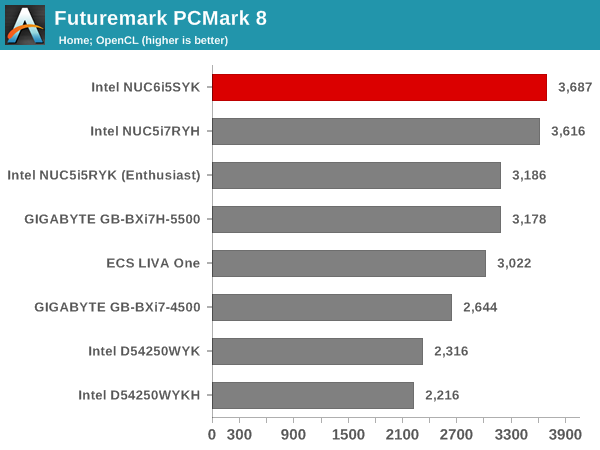
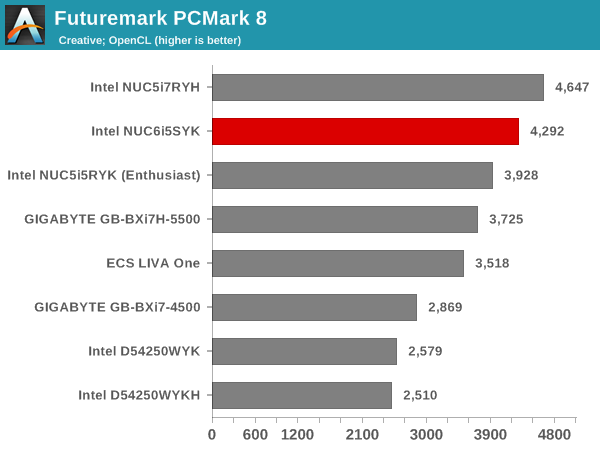
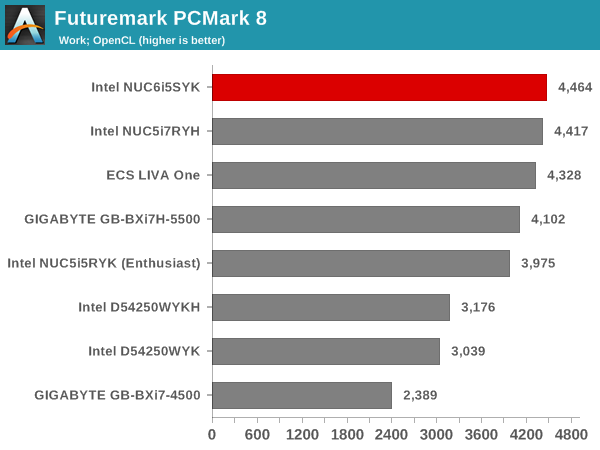
Miscellaneous Futuremark Benchmarks
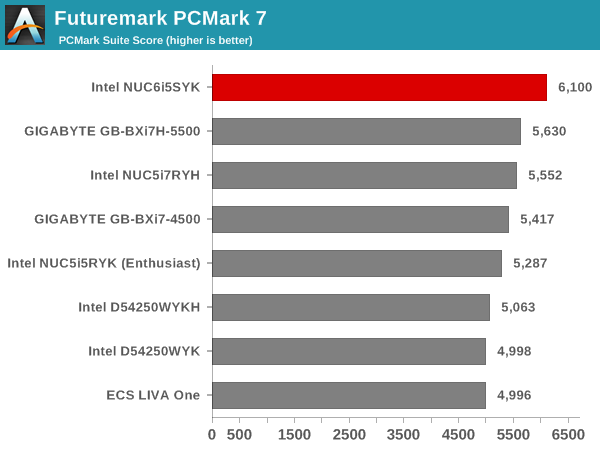
The Futuremark GPU benchmarks present a different story. The advancements in the Skylake GPU enable the Skylake NUC to easily outscore every other mini-PC that has been evaluated before.
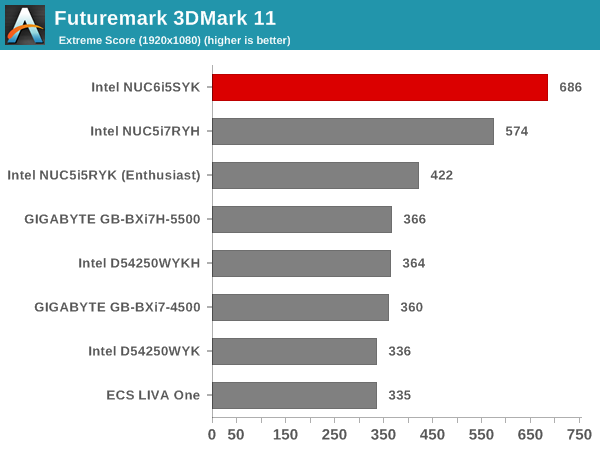
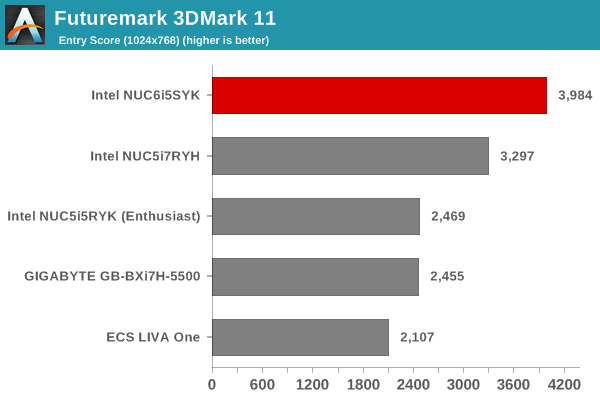
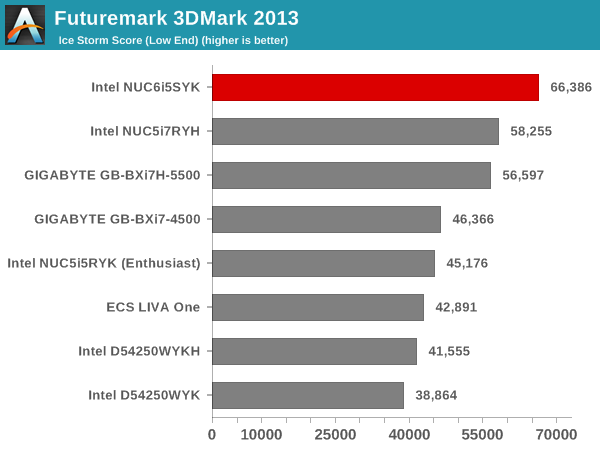
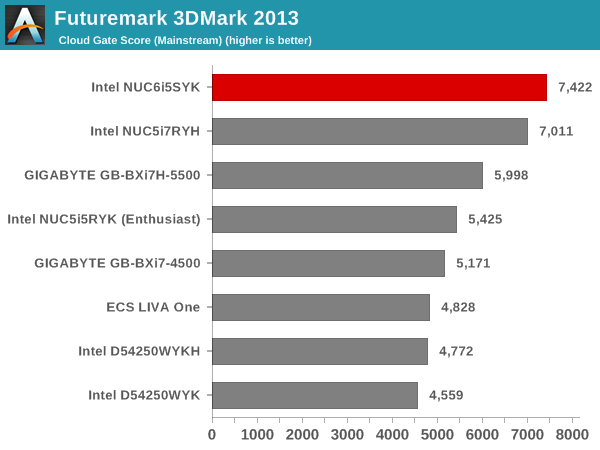
3D Rendering - CINEBENCH R15
We have moved on from R11.5 to R15 for 3D rendering evaluation. CINEBENCH R15 provides three benchmark modes - OpenGL, single threaded and multi-threaded. Evaluation of select PCs in all three modes provided us the following results. In the single threaded case, the higher clocks and TDP ratings help the NUC5i7RYH (based on the 28W TDP Core i7-5557U), ECS LIVA One (based on the 35W TDP Core i3-6100T) and the GIGABYTE GB-BXi7H-5500 (based on the Core i7-5500U - usual TDP of 15W configured upwards to 28W) to outscore the Skylake NUC (based on the 15W TDP Core i5-6260U).
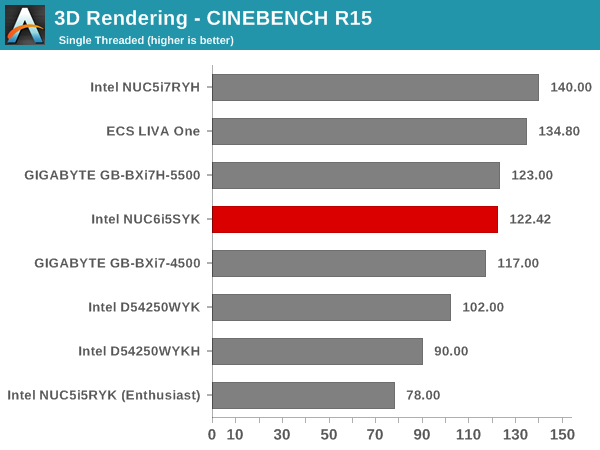
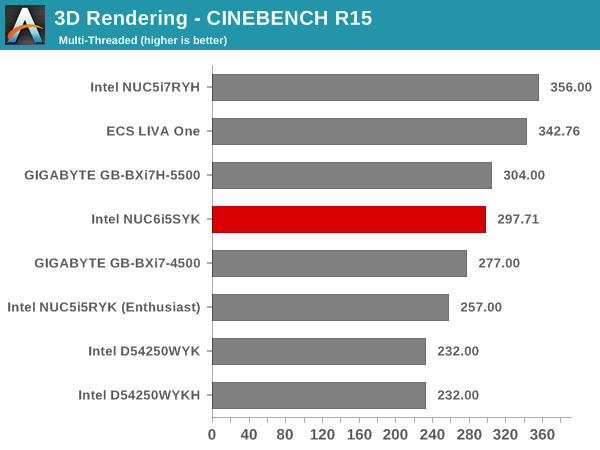
However, in the OpenGL case, the Skylake GPU with eDRAM enables the NUC6i5SYK to have a comfortable lead over other UCFF PCs.
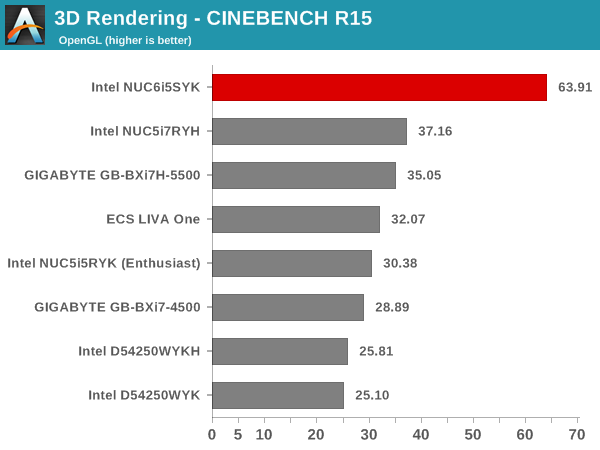
Performance Metrics - II
In this section, we mainly look at benchmark modes in programs used on a day-to-day basis, i.e, application performance and not synthetic workloads.
x264 Benchmark
First off, we have some video encoding benchmarks courtesy of x264 HD Benchmark v5.0. This is simply a test of CPU performance. As expected, the 35W TDP Core i3-6100T and the 28W TDP Core i5-5557U take the lead over the 15W Core i5-6260U.
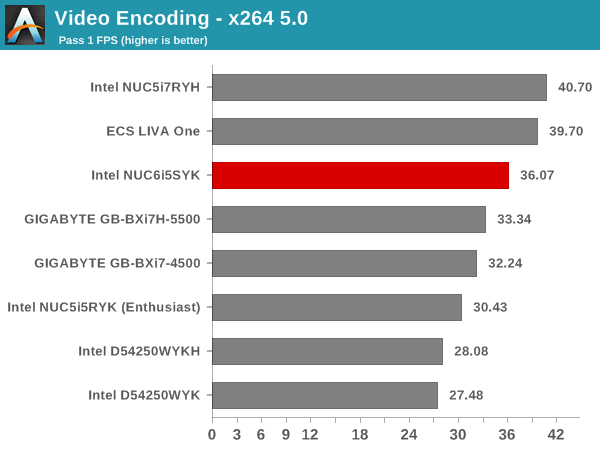
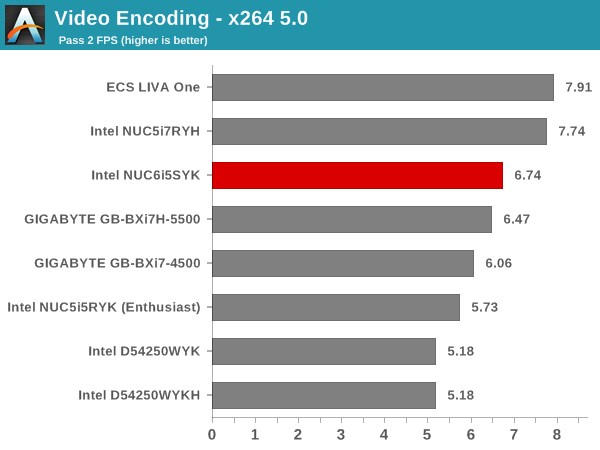
7-Zip
7-Zip is a very effective and efficient compression program, often beating out OpenCL accelerated commercial programs in benchmarks even while using just the CPU power. 7-Zip has a benchmarking program that provides tons of details regarding the underlying CPU's efficiency. In this subsection, we are interested in the compression and decompression MIPS ratings when utilizing all the available threads.
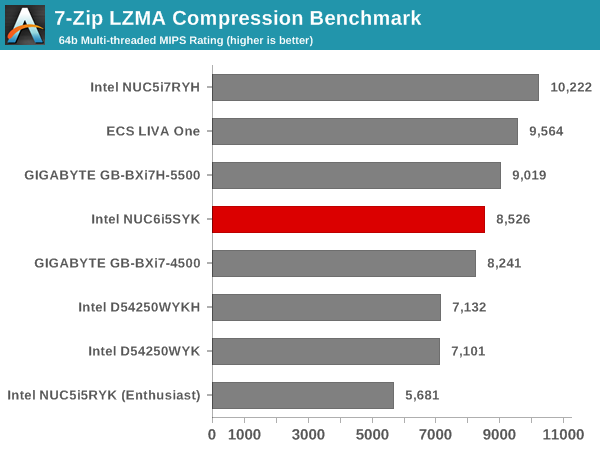
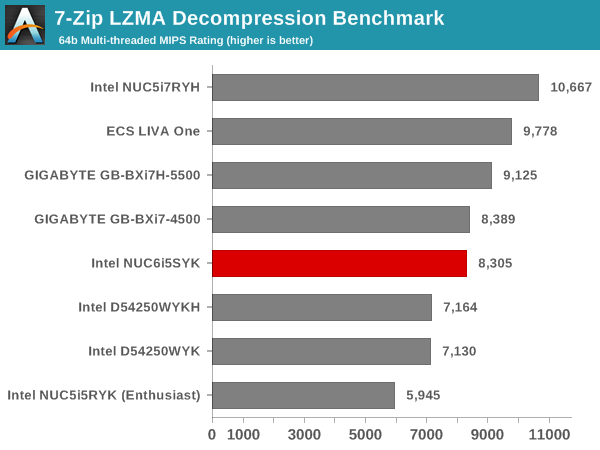
TrueCrypt
As businesses (and even home consumers) become more security conscious, the importance of encryption can't be overstated. CPUs supporting the AES-NI instruction for accelerating the encryption and decryption processes used to be restricted to high-end SKUs. That has changed now, and even the consumer-focused Core i5-6260U in the NUC6i5SYK has AES-NI support. TrueCrypt, a popular open-source disk encryption program can take advantage of the AES-NI capabilities. The TrueCrypt internal benchmark provides some interesting cryptography-related numbers to ponder. In the graph below, we can get an idea of how fast a TrueCrypt volume would behave in the Intel NUC6i5SYK and how it would compare with other select PCs. This is a purely CPU feature / clock speed based test.
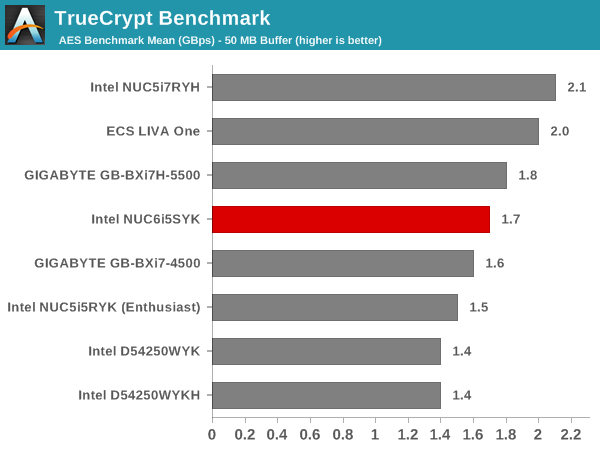
Agisoft Photoscan
Agisoft PhotoScan is a commercial program that converts 2D images into 3D point maps, meshes and textures. The program designers sent us a command line version in order to evaluate the efficiency of various systems that go under our review scanner. The command line version has two benchmark modes, one using the CPU and the other using both the CPU and GPU (via OpenCL). The benchmark takes around 50 photographs and does four stages of computation:
- Stage 1: Align Photographs
- Stage 2: Build Point Cloud (capable of OpenCL acceleration)
- Stage 3: Build Mesh
- Stage 4: Build Textures
We record the time taken for each stage. Since various elements of the software are single threaded, others multithreaded, and some use GPUs, it is interesting to record the effects of CPU generations, speeds, number of cores, DRAM parameters and the GPU using this software.
Bringing the GPU into the picture helps the NUC6i5SYK to emerge as the Stage 2 leader, but, in other stages, the raw CPU performance is held back by the lower TDP compared to some of the other PCs in the comparison list.
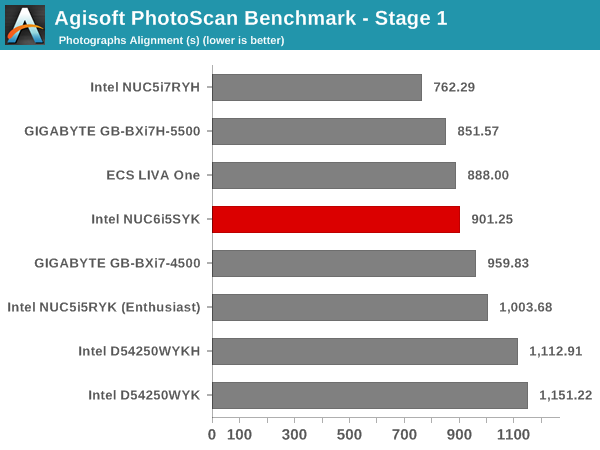
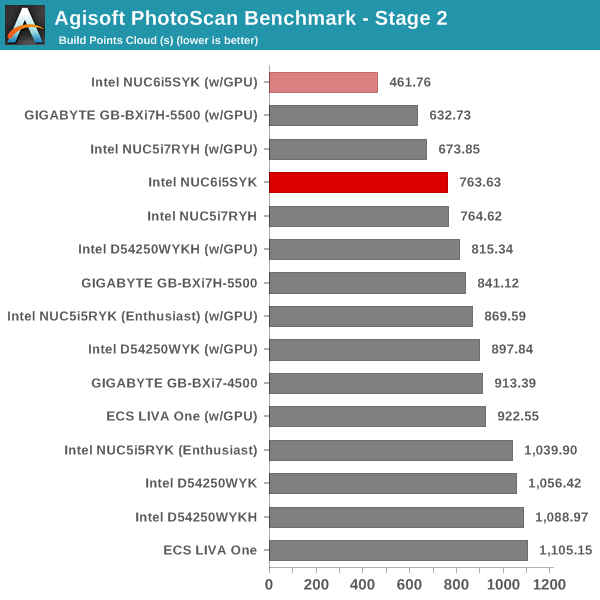
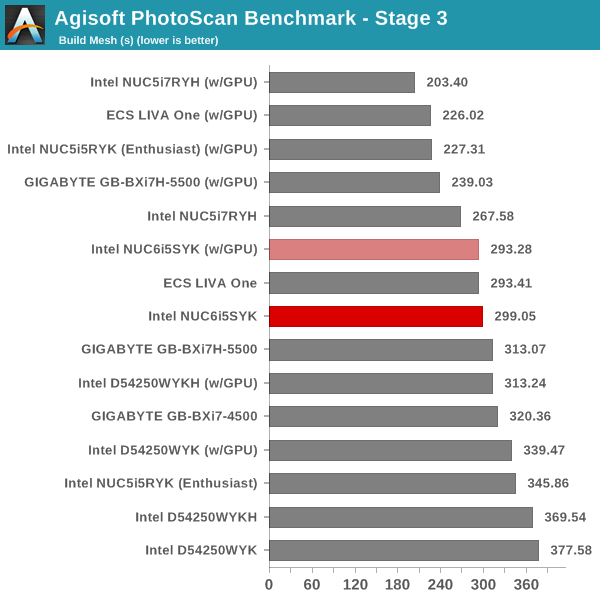
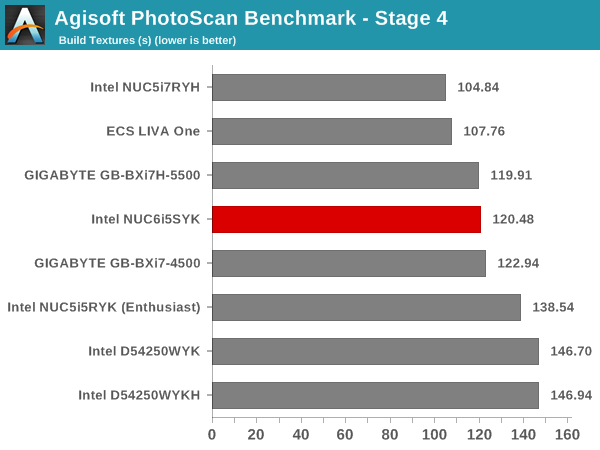
Dolphin Emulator
Wrapping up our application benchmark numbers is the Dolphin Emulator benchmark mode results. This is again a test of the CPU capabilities, and the higher TDP CPUs perform better.
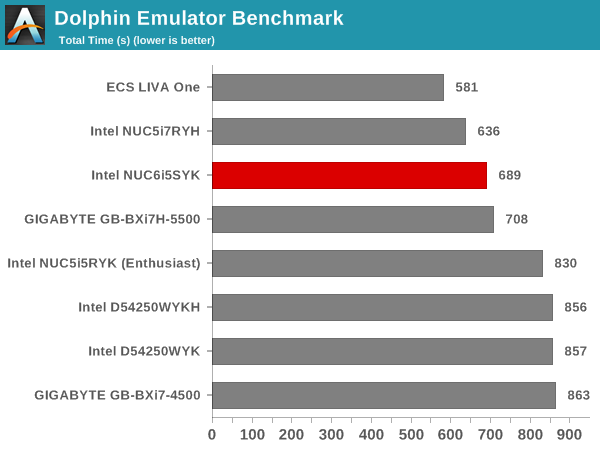
Networking and Storage Performance
Networking and storage are two major aspects which influence our experience with any computing system. This section presents results from our evaluation of these aspects in the Intel NUC6i5SYK. The NUC supports both M.2 SATA SSDs and M.2 PCIe SSDs (2242 / 2280). NVMe is also supported and provides the best possible performance. One of the evaluation options is a repetition of our strenuous SSD review tests on the drive in the PC. Fortunately, to avoid that overkill, PCMark 8 has a storage bench where certain common workloads such as loading games and document processing are replayed on the target drive. Results are presented in two forms, one being a benchmark number and the other, a bandwidth figure. We ran the PCMark 8 storage bench on selected PCs and the results are presented below.
Note that the problems we encountered with PCMark 8 and NVMe SSDs in a previous NUC review has been fixed now (by an update to PCMark 8). The benchmark now brings the full performance of the NVMe SSD to the forefront, yielding leading numbers in both the storage bench score as well as bandwidth. Unlike Broadwell-U, the M.2 SSD can interface with the Skylake package using a PCIe 3.0 x4 link (instead of PCIe 2.0 x4).
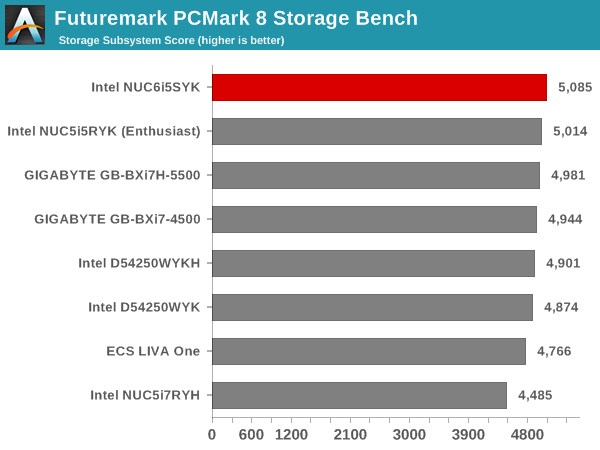
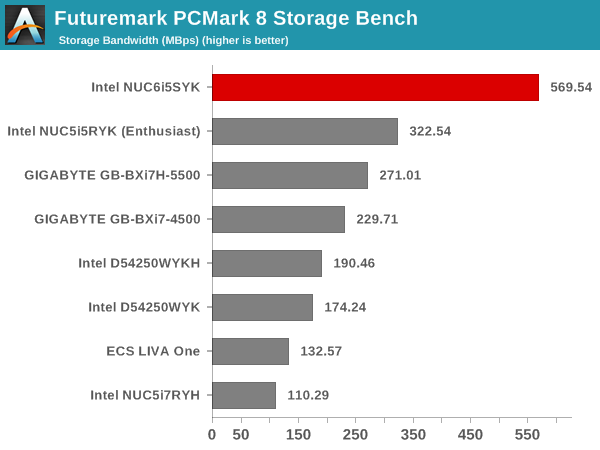
On the networking side, we restricted ourselves to the evaluation of the WLAN component. Our standard test router is the Netgear R7000 Nighthawk configured with both 2.4 GHz and 5 GHz networks. The router is placed approximately 20 ft. away, separated by a drywall (as in a typical US building). A wired client is connected to the R7000 and serves as one endpoint for iperf evaluation. The PC under test is made to connect to either the 5 GHz (preferred) or 2.4 GHz SSID and iperf tests are conducted for both TCP and UDP transfers. It is ensured that the PC under test is the only wireless client for the Netgear R7000.
The WLAN functionality in the NUC6i5SYK is handled by the Intel AC8260 2x2 802.11ac chipset. While the number of spatial streams supported is the same as the AC7265 used in the Broadwell NUCs, the AC8260 integrates Bluetooth 4.2 (compared to Bluetooth 4.0 in the AC7265).
We evaluate total throughput for up to 32 simultaneous TCP connections using iperf and present the highest number in the graph below.
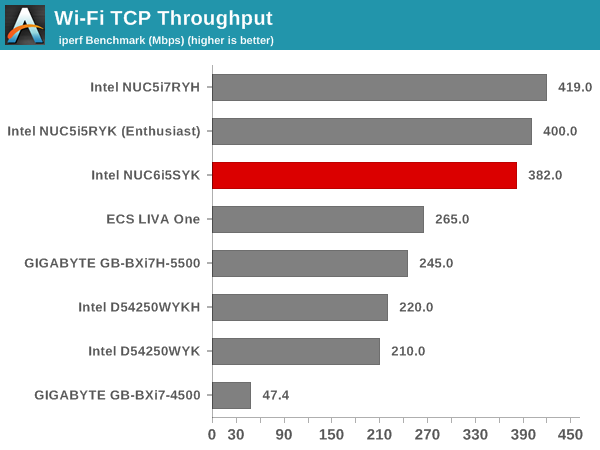
In the UDP case, we try to transfer data at the highest rate possible for which we get less than 1% packet loss.
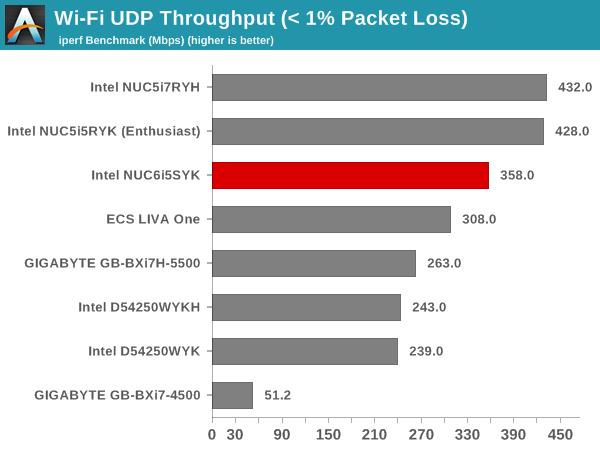
The benchmark numbers in both cases point to a retrogression in performance compared to the previous-generation AC7265 used in the Intel NUC5i5RYK and NUC5i7RYH. In addition, we ran into a strange issue with the WLAN component. Occasionally after startup, the Wi-Fi adapter wouldn't see any 5 GHz networks to connect to. Repeated restarts helped in resolving the problem. Apparently, we are not alone in noticing this behavior. Intel has also been able to recreate the problem at their end and efforts are on to resolve it.
HTPC Credentials
The thermal solution on the NUC6i5SYK is the same as what we have seen in the previous NUCs. Since the Core i5-6260U is a 15W TDP processor, the acoustics are pretty decent (when compared to the fans on the units with 28W TDP processors). Subjectively speaking, the unit is silent for most common HTPC use-cases. Only under heavy CPU / GPU loading (such as stressful madVR configurations) does the fan become audible. Like the previous NUCs, the NUC6i5SYK retains CIR support, enabling use of IR remotes in a home theater setting. The unit definitely makes a good HTPC for folks who don't want to pay the premium for a passively cooled system - however, we didn't find too many improvements over the previous NUCs for HTPC workloads. There is still no HDMI 2.0 / HDCP 2.2 / 4Kp60 HDMI support in the unit.
Refresh Rate Accuracy
Starting with Haswell, Intel, AMD and NVIDIA have been on par with respect to display refresh rate accuracy. The most important refresh rate for videophiles is obviously 23.976 Hz (the 23 Hz setting). As expected, the Intel NUC6i5SYK has no trouble with refreshing the display appropriately in this setting. In fact, the NUC6i5SYK has the most accurate display refresh rates of all the PCs that we have evaluated so far.
The gallery below presents some of the other refresh rates that we tested out. The first statistic in madVR's OSD indicates the display refresh rate.
Network Streaming Efficiency
Evaluation of OTT playback efficiency was done by playing back our standard YouTube test stream and five minutes from our standard Netflix test title. Using HTML5, the YouTube stream plays back a 1080p encoding. Since YouTube now defaults to HTML5 for video playback, we have stopped evaluating Adobe Flash acceleration. Note that only NVIDIA exposes GPU and VPU loads separately. Both Intel and AMD bundle the decoder load along with the GPU load. The following two graphs show the power consumption at the wall for playback of the HTML5 stream in Mozilla Firefox (v 44.0.2).
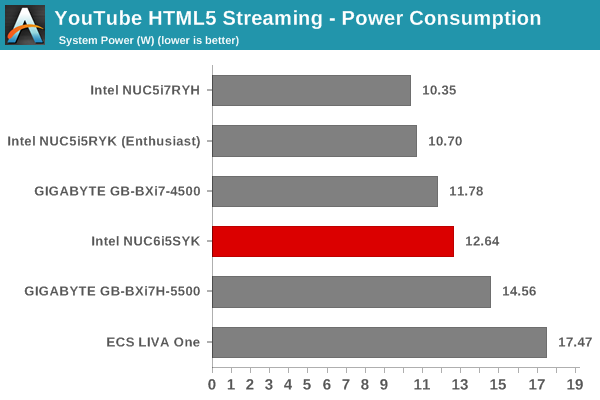
GPU load was around 24.27% for the YouTube HTML5 stream and barely measurable for the steady state 6 Mbps Netflix streaming case. Note that GPU usage reported by GPU-Z doesn't actually measure the load on the dedicated decoder engines in the GPU.
Netflix streaming evaluation was done using the Windows 10 Netflix app. Manual stream selection is available (Ctrl-Alt-Shift-S) and debug information / statistics can also be viewed (Ctrl-Alt-Shift-D). Statistics collected for the YouTube streaming experiment were also collected here.
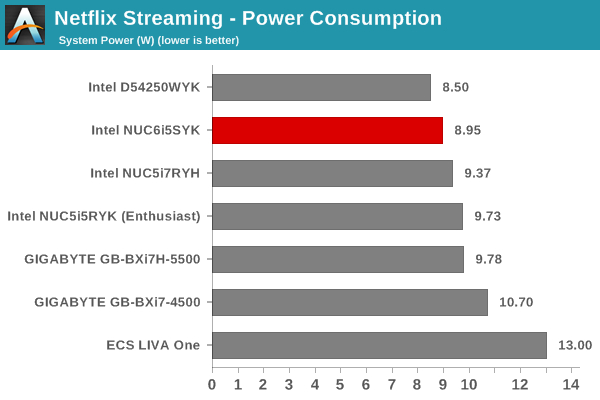
Decoding and Rendering Benchmarks
In order to evaluate local file playback, we concentrate on EVR-CP, madVR and Kodi 16.0. We already know that EVR works quite well even with the Intel IGP for our test streams. Under madVR, we used the DXVA2 scaling logic wherever available, and left the rest at default (as it is well known that the stressful configurations don't work even on the Iris Pro-equipped processors). We used the DXVA2 native decoder in the LAV Filters bundled with MPC-HC v1.7.10
In our earlier reviews, we focused on presenting the GPU loading and power consumption at the wall in a table (with problematic streams in bold). Starting with the Broadwell NUC review, we decided to represent the GPU load and power consumption in a graph with dual Y-axes. Nine different test streams of 90 seconds each were played back with a gap of 30 seconds between each of them. The characteristics of each stream are annotated at the bottom of the graph. Note that the GPU usage is graphed in red and needs to be considered against the left axis, while the at-wall power consumption is graphed in green and needs to be considered against the right axis.
Frame drops are evident whenever the GPU load consistently stays above the 85 - 90% mark. The NUC6i5SYK has absolutely no trouble with any of our test streams. Kodi is the most power efficient of the lot, while madVR with DXVA scaling is actually quite power efficient and comparable to EVR-CP.
Moving on to the codec support, the Intel Iris Graphics 540 is a known quantity with respect to the scope of supported hardware accelerated codecs. DXVA Checker serves as a confirmation. Recent driver updates have added VP9 decode support, but, only for 8b encodes.
Power Consumption and Thermal Performance
The power consumption of the NUC6i5SYK at the wall was measured with a 1080p display being driven through the HDMI port. In the graphs below, we compare the idle and load power of the Intel NUC6i5SYK with other low power PCs evaluated before. For load power consumption, we ran Furmark 1.12.0 and Prime95 v27.9 together. While the idle power number is consistent with a system sporting a 15W TDP processor, the load power is quite high at 38.37W (considering that the Haswell-based NUCs idled a full 10W lower while also using a 15W TDP processor).
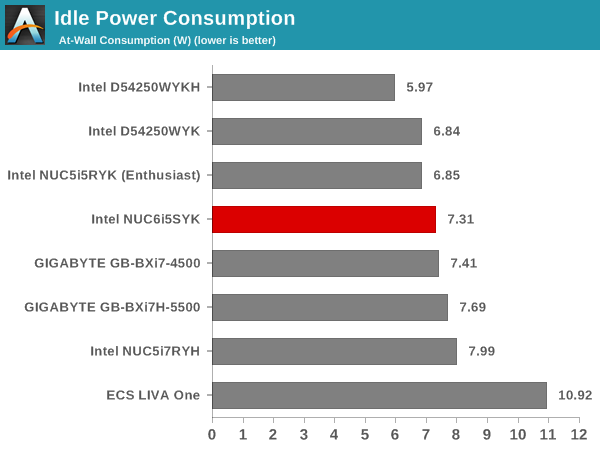
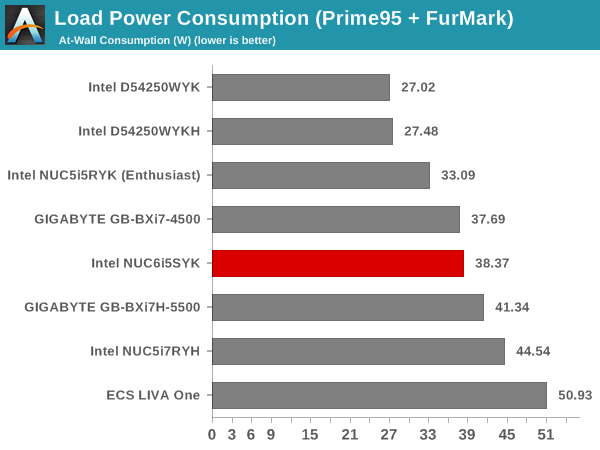
Analyzing the AIDA64 system report and the default BIOS configuration revealed that the unit was optimized for maximum performance. The long duration CPU power limit was set to 23W for a time duration window of 96s and the short duration CPU power limit was set to 30W for 2.44ms. For comparison, the Core i7-6600U in the Surface Book has a long duration CPU limit of 15W for 28s and a short duration limit of 25W for 2.44ms. As we shall see further down in this section, the Core i5-6260U in the NUC6i5SYK doesn't pull back significantly from the 23W limit even under sustained load (despite the 96s configuration).
Moving on to our thermal stress routine, we started with the system at idle, followed by 30 minutes of pure CPU loading. This was followed by another 30 minutes of both CPU and GPU being loaded simultaneously. After this, the CPU load was removed, and the GPU was loaded alone for another 30 minutes. The various clocks in the system as well as the temperatures within the unit are presented below.
We find that the cores spend very little time at the turbo speed of 2.9 GHz, but the steady clock rate is around 2.6 GHz throughout the duration when the CPU was completely loaded. The Core i5-6260U is advertised with a base clock of only 1.8 GHz. There is no throttling at play here even under full CPU load. However, when the GPU gets loaded , the cores drop down to around 1.1 GHz even under load. As we shall see further down, this is probably limited by package power. The GPU cores have a base frequency of 300 MHz (turbo to 950 MHz). Under load, we see it operate between 600 - 700 MHz depending on whether the CPU is loaded simultaneously or not.
According to the official specifications, the junction temperature of the Core i5-6260U is 100C. The thermal solution is more than good enough to maintain the temperature below 90C even under extreme stress. The cores also idle around 33C.
In addition to the frequencies and temperature, we also tracked the power consumption at the wall during the thermal stress testing process. Here, we find that the performance of the system is actually limited by the maximum sustained power consumption limit (around 38W under the tested load conditions) for the system. Irrespective of the CPU and GPU loading, the power consumption is kept under these limits (except for the short spike close to 48W corresponding to the Short Duration Power Limit reported by CPUID).
Since the NUC6i5SYK is not a passively cooled PC, we decided to skip our usual thermal photographs. Given the observed internal temperatures during thermal stress testing and the thermal design (case with adequate number of vents, a blower solution and a plastic lid), we believe that the external case temperatures will not be a cause for concern even under heavy system load.
Final Words
The Intel NUC6i5SYK has been in the market since late last year, and we were really excited to finally receive a review sample last month. The NUCs have become one of the most promising desktop PC segments for Intel, and Skylake definitely has the necessary features to drive up the performance per watt metric. With full PCIe 3.0 x4 capability for the M.2 SSD and cutting-edge DDR4 support, the Skylake NUC has piqued the interest of the enthusiasts too. Getting more of the good things out of the way - the Skylake-U platform (Sunrise Point-LP chipset) also brings support for SDXC 3.0, enabling a dedicated UHS-I SDXC card reader slot in the Skylake NUC. The full-sized HDMI port addresses one of the major complaints we have had about the NUCs up to now. We are quite happy with the evolutionary updates made in the Skylake NUC.
The thermal design continues to be good, and the default BIOS configuration ensures that the Core i5-6260U can sustain higher operational power levels than what is suggested by its TDP of 15W. This is particularly interesting, since the processor doesn't officially have a configurable higher TDP. The Skylake GPU has also shown tremendous improvement compared to Broadwell and previous generations, and this is evident in the 3D benchmarks. The NUC6i5SYK also sports an Iris GPU with 64MB of eDRAM that helps improve performance for various workloads.
The pricing ($386 on Amazon for the barebones version) is also very reasonable for the performance numbers. With DDR4 SODIMM prices on the way down, and a Samsung 950 Pro 256 GB costing around $180, it is possible to complete the build for less than $650.
Unfortunately, at the business end of the review, we have to say that the Skylake NUC6i5SYK is not ready for prime time yet. In our evaluation process, we encountered two showstopper issues, one of which ended up in our first review sample getting bricked. In Intel's defense, they were already aware of the issues prior to our report.
- Compatibility issues with SODIMMs using Hynix memory modules that might make installing Windows impossible and even BIOS flashing fraught with risk
- OS lockup under certain GPU loading scenarios
BIOS version 0036 has a fix for the first problem problem, but the default settings in that BIOS are still incompatible with SODIMMs using Hynix memory modules. The latest GPU driver downloaded from Intel's site resolves the second issue. However, the nagging problem with the AC8260 WLAN adapter (occassionally missing 5 GHz SSIDs) still remains.
Other minor drawbacks (applicable to Skylake as a whole) include the absence of full hardware acceleration for HEVC Main10 decode as well as the absence of HDMI 2.0a / HDCP 2.2 support. Even though the hardware is quite powerful, these two aspects prevent us from recommending it as a primary HTPC. Broadwell NUCs are more mature and can provide very similar HTPC functionality at a lower price point.
Overall, our experience with the NUC6i5SYK was not what we have come to expect from a typical Intel product. Unless one wants to be an adventurous beta tester, we would suggest waiting for Intel to resolve all pending issues with the Skylake NUC before contemplating a purchase. Hopefully, the Iris Pro-equipped Skull Canyon NUC (with Thunderbolt 3 integrated) will fare better when it comes to the market.
Update (May 17, 2016): Intel has been releasing BIOS updates regularly since this review was posted. From the review changelog and follow-up testing, it appears that BIOS v0044 has resolved almost all of the issues that we have complained about in this review.

